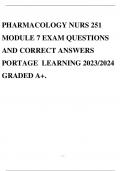PHARMACOLOGY NURS 251
MODULE 7 EXAM QUESTIONS
AND CORRECT ANSWERS
PORTAGE LEARNING 2023/2024
GRADED A+.
,1. organs of the upper gastrointestinal tract: mouth, pharynx, esophagus, stom-ach, and duodenum
- work in conjunction to first digest food and then absorb the nutrients obtained fromthe digested food.
2. stomach and the upper part of the small intestines: release hormones andenzymes that help in
this process.
3. When food enters the body,: the stomach is triggered to begin releasing gastricjuices such as
hydrochloric acid (HCl) and an enzyme called pepsin.
4. HCl: released by parietal cells located in the stomach. Due to its acidic nature,HCl aids in the
breakdown of food entering the stomach
5. Pepsin: the primary digestive enzyme found in the stomach. Pepsin is responsiblefor the catabolism
(breaking down) of proteins into polypeptides.
6. three major stimulators that affect the release of gastric juices: Acetylcholine(ACh), gastrin, and
histamine.
7. release of gastric juices:: First, the ingestion of food stimulates ACh to bind to itstarget receptors,
stimulating the release of pepsin, gastrin, histamine, and HCl fromchief cells, G cells, enterochromaffin
like (ECL) cells, and parietal cells respectively.Gastrin then binds to its target receptors on ECL and
parietal cells which stimulatesthe release of more histamine and more HCl. The histamine then binds to
the H2 receptors on the parietal cells which, in turn, increases the amount of HCl or gastricacid released.
8. Peptic ulcers: open sores in the mucous membranes of the mucosal lining of thestomach or
duodenum.
9. Pathophysiology of peptic ulcers: The cause of peptic ulcers is not always thesame. The majority of
GI ulcers are caused by the bacterium Helicobacter Pylori (H.Pylori). The bacterium is believed to enter
the body through contaminated food or water. Reacting to the bacteria, an inflammatory response is
initiated, which is oftenassociated with an increase in stomach acid secretions.
The long-term use of non-steroidal anti-inflammatory drugs (NSAIDs) is also closely related to the
incidence of peptic ulcers. NSAIDs block prostaglandins which play a role in inhibiting gastric acid
secretion.
In both cases, the resulting increase in stomach acid secretions places a strain onthe inner lining of the
stomach until an ulcer (break or tear) appears.
,10. Symptoms of a peptic ulcer: pain, nausea, and loss of appetite. The pain is typically described
as a dull, gnawing, burning sensation similar to heartburn.
Interestingly, if the ulcer is in the duodenum, food often relieves the pain, whereasif the ulcer is in the
stomach, food often worsens the pain.
, 11. Peptic Ulcers treatment: If the patient has a peptic ulcer that is caused by H.Pylori, they will
need to be treated with antibiotics.
- The recommended antibiotics to treat H. pylori include amoxicillin, tetracycline,metronidazole,
and clarithromycin.
- The purpose of the Pepto-Bismol is that bismuth is thought to disrupt the bacterialcell wall and prevent
further binding to the mucosa. Treatment typically lasts for 8 weeks leading to the eradication of the
bacteria.
triple therapy: two antibiotics in combination with bismuth salts (Pepto-Bismol orKaopectate),
quadruple therapy: When a proton pump inhibitor (PPI) is added to the regimen
If the ulcer was not caused by H. Pylori, treatment does not involve antibiotics butrather anti-secretory
drugs.
- Anti-secretory drugs are defined as drugs that inhibit the secretion of diges- tive enzymes,
hormones, or acids. Such drugs include H2 receptor antagonists,prostaglandins, and proton pump
inhibitors. Treatment should last 4-8 weeks.
Prostaglandins are only useful in the treatment or prevention of NSAID-induced ulcers. Prostaglandins
inhibit histamine which counteracts the NSAIDs inhibition of prostaglandin synthesis. There is only
one synthetic prostaglandin available, misoprostol. It is limited in its use, primarily being used for
patients at high risk of developing an ulcer that must be on an NSAID for a limited time. Misoprostol
hasnot been shown to be effective at preventing ulcers in patients on chronic NSAIDtherapy.
Misoprostol is also known to cause uterine contractions and is, therefore,contraindicated in pregnancy
due to the risk of miscarriage.
12. GERD: stands for gastrointestinal esophageal reflux disease and is character-ized primarily by the
presence of heartburn.




